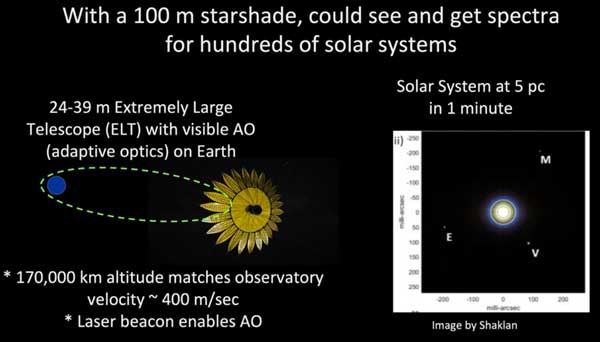
by Douglas Messier
Managing Editor
NASA is funding research by John Mather of Goddard Space Flight Center into the development of a massive orbiting star shade that would allow ground-based telescopes to search for Earth-like exoplanets.
“We propose the first hybrid observatory, combining a 100 m diameter starshade in space with a telescope on the ground,” the proposal abstract said. “The Hybrid Observatory for Earth-like Exoplanets (HOEE) would convert the largest ground-based telescopes now under construction (Giant Magellan Telescope, Thirty Meter Telescope, and Extremely Large Telescope) into the most powerful planet finders yet designed. No other proposed equipment can match the angular resolution (image sharpness), sensitivity (ability to see faint objects in a given time), or contrast (ability to see faint planets near bright stars).
“The large telescope is needed because Earth-like planets are extremely faint. The starshade is needed to block the glare of the host stars; the sun is 10 billion times brighter than the Earth at visible wavelengths. A starshade in an astro-stationary orbit would match position and velocity with the moving telescope, and cast a dark shadow of the star, without blocking the light of its planets. Active propulsion would maintain alignment during the observation. Adaptive optics in the telescope would compensate for atmospheric distortion of the incoming images,” the document added.
The space agency selected Mather for a NASA Innovative Advanced Concepts (NIAC) Phase I award worth $175,000 to conduct a nine-month study of the concept.
The project abstract follows.
Hybrid Observatory for Earth-like Exoplanets (HOEE)
John Mather
NASA Goddard Space Flight Center
NIAC Phase I
Amount: $175,000
Length: 9 months
We propose the first hybrid observatory, combining a 100 m diameter starshade in space with a telescope on the ground. The Hybrid Observatory for Earth-like Exoplanets (HOEE) would convert the largest ground-based telescopes now under construction (Giant Magellan Telescope, Thirty Meter Telescope, and Extremely Large Telescope) into the most powerful planet finders yet designed. No other proposed equipment can match the angular resolution (image sharpness), sensitivity (ability to see faint objects in a given time), or contrast (ability to see faint planets near bright stars).
The large telescope is needed because Earth-like planets are extremely faint. The starshade is needed to block the glare of the host stars; the sun is 10 billion times brighter than the Earth at visible wavelengths. A starshade in an astro-stationary orbit would match position and velocity with the moving telescope, and cast a dark shadow of the star, without blocking the light of its planets. Active propulsion would maintain alignment during the observation. Adaptive optics in the telescope would compensate for atmospheric distortion of the incoming images.
The HOEE would address the highest priority recommendation of the Exoplanet Strategy report: observe reflected light from Earth-like planets with low resolution spectroscopy. This light is influenced by surface minerals, oceans, continents, weather, vegetation, and atmospheric constituents, temperature, and pressure. Observing many systems would help answer the question of why configurations like our own Solar System are rare; of the thousands of known exoplanet systems, none are quite like home, with inner rocky planets, a faint cloud of dust, an asteroid belt, and giant outer planets.
Observing photosynthetic oxygen would answer the questions of whether life is rare or common, what it requires, and how long it takes to grow. But this starshade is not constructible with today’s designs. An ultra-lightweight redesign will be developed that can be built or assembled in space. Our objective is to cut the starshade mass by more than a factor of 10. There is no reason to require thousands of kg to support 400 kg of thin membranes.
The HOEE depends on two major innovations: a ground-space hybrid observatory, and an extremely large telescope on the ground. The tall pole requiring design and demonstration is the mechanical concept of the starshade itself. It must satisfy conflicting requirements for size and mass, shape accuracy and stability, and rigidity during or after thruster firing. Low mass is essential for observing many different target stars. If it can be assembled or constructed after launch, it need not be built to survive launch. We believe all requirements can be met, given sufficient effort. The HOEE is the most powerful exoplanet observatory yet proposed.

